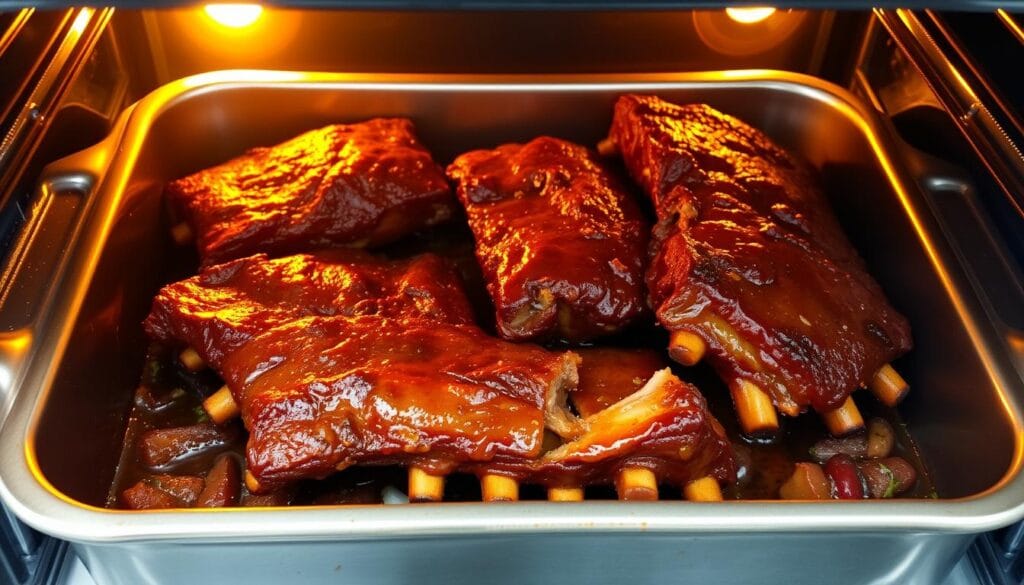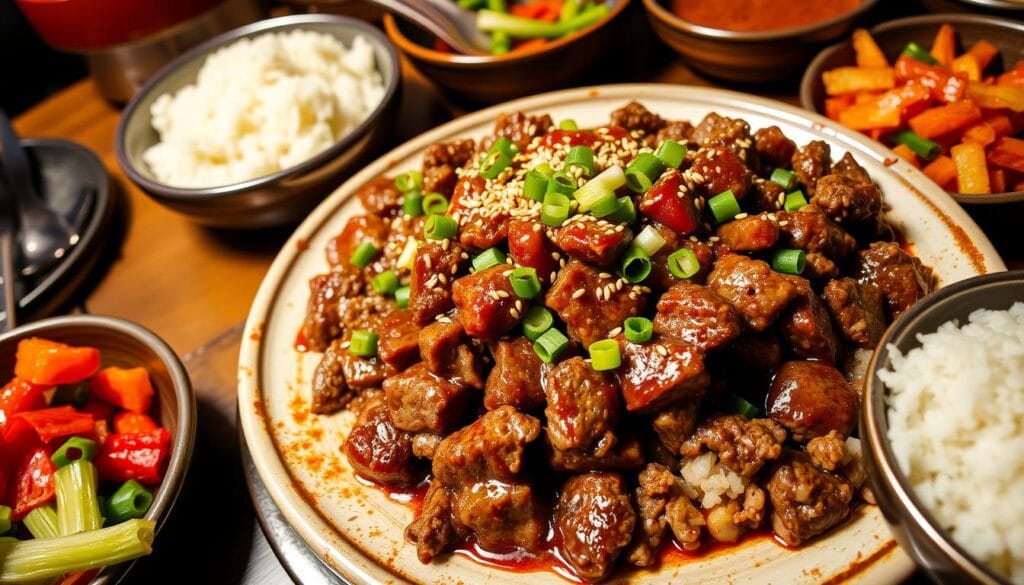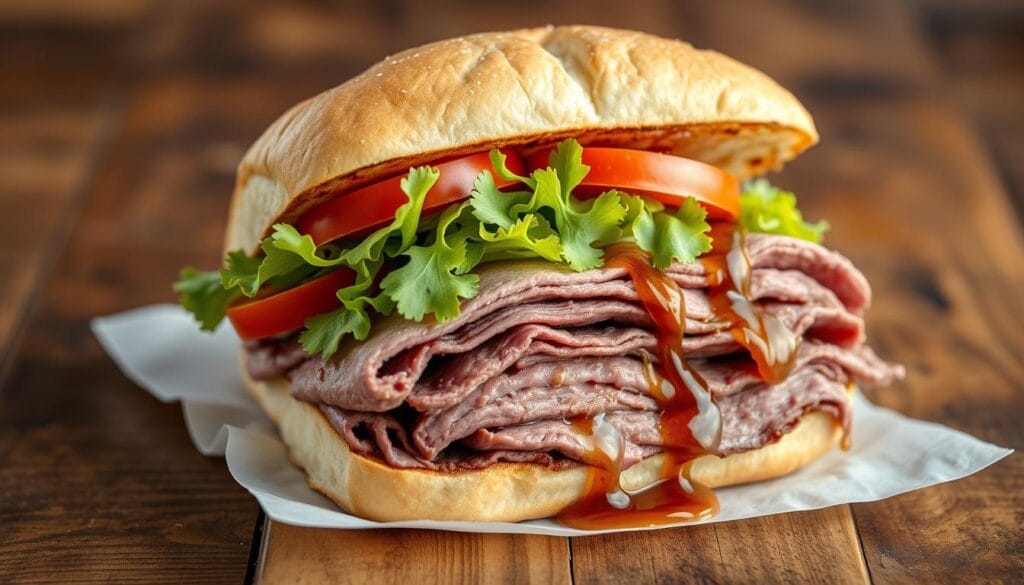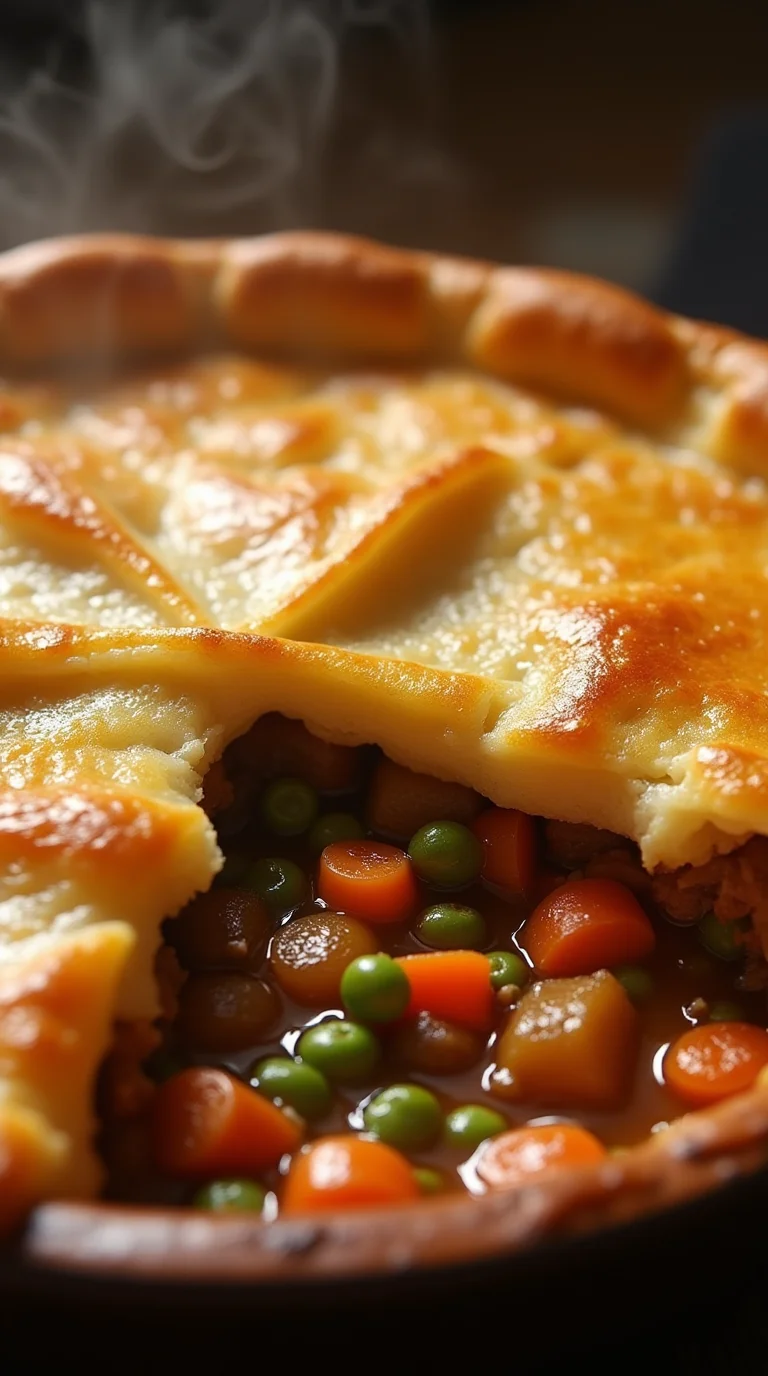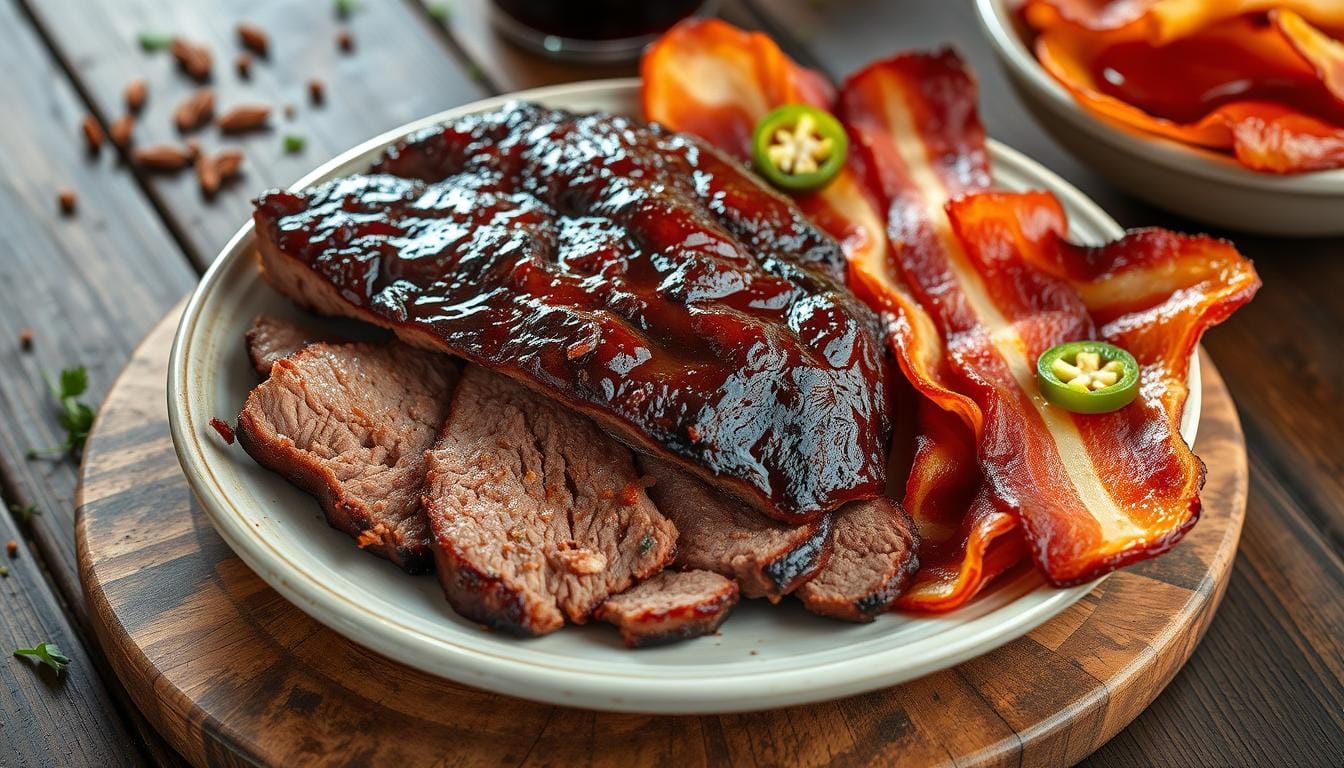Recall that initial moment, that singular experience when a particular dish transcended mere sustenance and imprinted itself upon your memory. For me, that moment arrived with a meal that achieved an exquisite balance of sweet and savory notes, punctuated by a delicate warmth, where each yielding slice of beef dissolved effortlessly on the palate.
That sensation transports me back to the compelling allure of Mongolian Beef – a preparation that, despite its nomenclature, boasts a captivating trajectory from its probable beginnings to its status as a widely cherished takeaway staple.
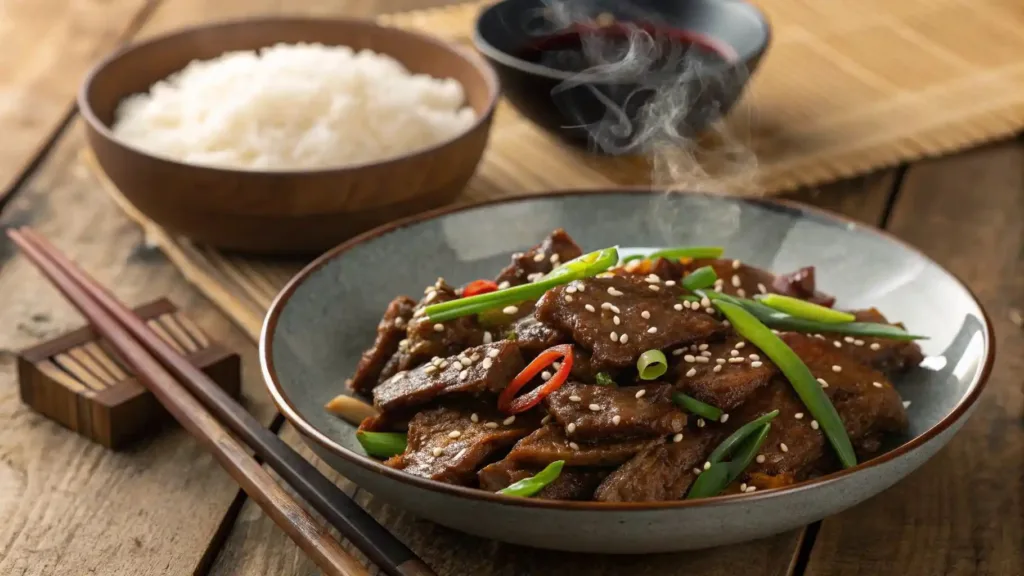
It is more than simply nourishment; it is an adventure, a harmonious blend of tastes that conjures feelings of comfort, exhilaration, and a hint of the exotic.
Permit me to guide you as we delve into the enigma behind this iconic creation and uncover precisely how you can replicate that culinary marvel within the sanctuary of your own kitchen.
The Enigmatic Origins of Mongolian Beef
Is Mongolian Beef Truly Mongolian? Unraveling the Mystery
Despite its widely recognized name, an intriguing fact about Mongolian Beef is that it does not, in fact, originate from Mongolia itself. If you’ve ever savored its distinctive flavors and pondered its geographical roots, you might be surprised to learn that this beloved dish is a quintessential product of Chinese-American culinary innovation, with strong ties to Taiwan.
You see, the dish as we know it today, with its tender slices of beef bathed in a glistening, flavorful sauce, is a creation born out of the ingenuity of chefs who adapted traditional Chinese stir-frying techniques for a new audience. Historically, “Mongolian barbecue” emerged in Taipei during the 1950s.

This was a concept where patrons would select raw ingredients, including various meats and vegetables, which were then cooked on large, flat griddles in a theatrical manner. The term “Mongolian” was likely employed for its perceived exoticism and marketing appeal, rather than any genuine connection to Mongolian gastronomy.
It conjured an image of vast steppes and hearty nomadic cuisine, a captivating narrative that resonated with diners. Therefore, when you order or prepare Mongolian Beef, you are engaging with a culinary tradition that, while incredibly delicious, is far removed from the actual culinary practices of Mongolia, where dishes like buuz (dumplings) or khorkhog (meat cooked with hot stones) are more representative.
Your taste buds are, in essence, experiencing a delightful fusion, a testament to culinary evolution.
A Fusion of Flavors: How a Classic Was Born
The genesis of Mongolian Beef lies in a fascinating interplay of traditional Chinese cooking methods and the desire to create new, appealing flavors for a new audience. Think about the fundamental elements of Chinese stir-frying: the rapid cooking over high heat, the precise cutting of ingredients, and the meticulous balancing of sweet, savory, and sometimes spicy components. These elements are all deeply ingrained in the lineage of Mongolian Beef.
Chefs, particularly those in Taiwan during the mid-20th century, took these established techniques and began experimenting. They drew inspiration from various regional Chinese stir-fries, which often feature thinly sliced meats and a rich, clingy sauce.
The concept of “Mongolian Barbecue” provided a creative framework, and from this, a distinct stir-fried beef dish began to take shape. The emphasis shifted from grilling on large griddles to the more conventional wok-based stir-frying, which proved more practical for restaurant kitchens.
The resulting dish, which would become known as Mongolian Beef, married the captivating “Mongolian” branding with the familiar and comforting profiles of Chinese-American cuisine. It was an adaptation, a reimagining, that ultimately secured its place as a perennial favorite on menus across the globe. You are, in essence, enjoying a delightful culinary narrative, a story told through flavor.
What Makes Mongolian Beef So Irresistible?
The Signature Sweet and Savory Sauce: A Symphony of Taste
The heart and soul of any truly memorable Mongolian Beef lies unequivocally in its distinctive sauce. It’s this lusciously thick, glossy, and perfectly balanced concoction that transforms simple beef into a culinary marvel. When you taste it, you encounter a captivating dance between contrasting yet complementary flavors: the deep, umami richness, the comforting sweetness, and the subtle, aromatic warmth that lingers on your tongue.
Let’s dissect the components that contribute to this irresistible symphony:
- Soy Sauce: This forms the fundamental savory base. It provides that essential umami depth and a foundational saltiness that anchors the entire flavor profile. The quality of your soy sauce will genuinely influence the overall taste of your Mongolian Beef, so opt for a good one.
- Brown Sugar: Here’s where the “sweet” in the sweet and savory comes from. Brown sugar not only imparts a rich, molasses-like sweetness but also contributes to the beautiful caramelization and glistening sheen of the sauce as it cooks. It’s crucial for achieving that characteristic “sticky” quality.
- Garlic and Ginger: These are the aromatic powerhouses. Minced garlic delivers a pungent, savory kick, while fresh ginger offers a bright, slightly spicy zest. Together, they infuse the oil and the sauce with a foundational warmth and complexity that is utterly essential to the dish’s allure. Without them, your Mongolian Beef would simply lack its signature aromatic backbone.
- Hoisin Sauce (Optional, but Recommended): While not always in every traditional recipe, a touch of hoisin sauce can elevate your Mongolian Beef. Hoisin adds a layer of fermented sweetness, a slight tang, and an even richer, deeper umami note, contributing to a more nuanced and complex flavor profile. If you desire that extra layer of depth, don’t hesitate to incorporate it.
- Cornstarch Slurry: This humble mixture of cornstarch and water is the secret to the sauce’s characteristic thickness and glossy texture. It allows the sauce to beautifully cling to every piece of beef, ensuring each mouthful is enveloped in that irresistible flavor. When you see that perfectly coated beef, you know the cornstarch has done its job.
The interplay of these elements creates a flavor profile that is profoundly satisfying and universally appealing, making Mongolian Beef a constant craving for many.
The Perfect Cut: Achieving Tender Mongolian Beef
Achieving that melt-in-your-mouth tenderness in your Mongolian Beef is not solely about the cooking process; it begins with your choice of beef and how you prepare it. You want to select a cut that responds well to high-heat, quick cooking methods like stir-frying.
The most commonly recommended cuts for Mongolian Beef include:
- Flank Steak: This is arguably the most traditional choice. Flank steak has a robust beefy flavor and, when prepared correctly, can become incredibly tender.
- Sirloin Steak: Another excellent option, sirloin is often more readily available and can be more economical than flank steak. It offers a good balance of flavor and tenderness.
- Thinly Sliced Ribeye: If you’re seeking a more luxurious experience, ribeye can be an exceptional choice, known for its marbling and inherent tenderness.
Regardless of the cut you select, the crucial technique is slicing against the grain. If you examine a piece of beef, you’ll notice long muscle fibers running in a particular direction. Cutting against these fibers shortens them, breaking down the tough connective tissues and ensuring that each piece of beef is remarkably tender when cooked. Aim for thin, uniform slices – roughly 1/4 inch thick – to ensure even and rapid cooking.
Beyond slicing, the technique of velveting the beef is your ultimate secret weapon for achieving truly restaurant-quality tenderness in your Mongolian Beef. This traditional Chinese method involves coating the thinly sliced beef in a mixture before cooking. Common velveting agents include:
- Cornstarch: This creates a protective coating that locks in moisture and helps to tenderize the meat, preventing it from becoming dry and tough during the high-heat cooking process.
- Baking Soda: A small amount of baking soda, when mixed with water and allowed to marinate with the beef, works as a powerful tenderizer. It slightly raises the pH of the meat, causing the muscle fibers to relax and separate, resulting in an incredibly soft texture. You’ll typically rinse the beef thoroughly after velveting with baking soda to remove any residual taste.
By selecting the right cut, slicing meticulously against the grain, and employing the velveting technique, you are laying the groundwork for a Mongolian Beef that is spectacularly tender and enjoyable to consume. Your efforts in this preparation phase will pay dividends in every single bite.
The Art of the Wok: Stir-Frying for Success
While you can certainly achieve a delicious outcome using a large skillet, the traditional tool for stir-frying, and indeed for producing truly exceptional Mongolian Beef, is the wok. The design of a wok offers distinct advantages that contribute significantly to the quality of your finished dish.
Consider the inherent characteristics of a wok:
- Concave Shape and Sloping Sides: This unique design is paramount. It allows for a small, intensely hot “hot zone” at the bottom, ideal for searing, while the sloping sides provide cooler areas where you can push partially cooked ingredients to prevent overcooking. This multi-temperature environment is crucial for stir-frying various ingredients that require different cooking times.
- Even Heat Distribution: Good woks, particularly those made from carbon steel, heat up rapidly and distribute that heat remarkably evenly across their surface. This ensures that all your ingredients cook uniformly and quickly, preventing some pieces from burning while others remain undercooked.
- Ease of Tossing and Stirring: The high, sloped sides of a wok make it incredibly easy to toss and flip ingredients without them spilling out. This constant movement is essential for stir-frying, allowing for even cooking and optimal caramelization of your Mongolian Beef.
- Versatility: Beyond stir-frying, a wok is a multi-functional piece of cookware. Its depth makes it excellent for deep-frying (think crispy beef pieces!), steaming, braising, and even making soups.
When stir-frying your Mongolian Beef, remember the cardinal rule: high heat and quick cooking. This technique is what gives stir-fried dishes their characteristic texture – a tender interior with a slightly crisp exterior. It’s also vital to cook in batches if you are preparing a larger quantity of beef. Overcrowding your wok or skillet will dramatically lower the temperature, causing the beef to steam rather than sear, resulting in a less desirable, tougher texture. You want that sizzle, that rapid browning, that signifies proper stir-frying.
Embracing the art of the wok, or at least understanding its principles, will elevate your Mongolian Beef from merely good to truly outstanding. Your culinary efforts will be rewarded with a dish that rivals your favorite takeout.
Crafting Your Own Masterpiece: A Step-by-Step Guide to Homemade Mongolian Beef
Now that you understand the nuances of this incredible dish, let’s guide you through the process of creating your own truly exceptional homemade Mongolian Beef. You’ll discover that while it appears sophisticated, the steps are entirely approachable, leading to a result that is deeply satisfying.
Essential Ingredients for Authentic Mongolian Beef
To embark on your Mongolian Beef journey, you’ll want to gather the following essential components. The freshness and quality of your ingredients genuinely impact the final flavor profile:
- For the Beef:
- 1 to 1.5 pounds beef (flank steak or sirloin, thinly sliced against the grain)
- 1 tablespoon cornstarch (for velveting)
- 1 teaspoon baking soda (optional, for extra tenderizing, rinse thoroughly after marinating)
- 1 tablespoon vegetable oil (for velveting)
- For the Sauce:
- ½ cup low-sodium soy sauce
- ½ cup packed brown sugar
- 1 tablespoon fresh ginger, minced
- 4-5 cloves garlic, minced
- 2 tablespoons hoisin sauce (optional, for richer flavor)
- ¼ teaspoon red pepper flakes (optional, for a touch of heat, adjust to your preference)
- ½ cup water or beef broth
- 2 tablespoons cornstarch (for thickening the sauce)
- For Cooking:
- 2-3 tablespoons vegetable oil (or another neutral oil like peanut or canola oil, for stir-frying)
- 4-5 green onions, chopped into 1-inch pieces (both white and green parts)
Prep Like a Pro: Marinating and Slicing
The secret to perfectly tender Mongolian Beef often lies in the preparatory steps you take before any heat touches your pan. This phase is where you genuinely set the stage for success.
- Slice the Beef: Take your chosen beef cut (flank or sirloin) and, crucially, slice it thinly against the grain. You’ll notice the muscle fibers running in a particular direction; cut perpendicular to these lines. Aim for slices that are about 1/4-inch thick and 1 to 2 inches long. This technique shortens the muscle fibers, making the beef wonderfully tender.
- Velvet the Beef: In a medium bowl, combine your sliced beef with 1 tablespoon of cornstarch, 1 tablespoon of vegetable oil, and if using, the 1 teaspoon of baking soda. Toss everything together until the beef is thoroughly coated. If you used baking soda, you’ll want to let this marinate for about 15-20 minutes in the refrigerator, then rinse the beef very well under cold running water to remove any baking soda residue. Pat the beef thoroughly dry with paper towels – this is vital for achieving a good sear later. If you’re only using cornstarch and oil, a 15-minute marinade is sufficient, and no rinsing is required. This coating is what helps keep your Mongolian Beef moist and ensures a delightful texture.
- Prepare the Sauce: In a separate bowl, whisk together the low-sodium soy sauce, brown sugar, minced ginger, minced garlic, hoisin sauce (if using), red pepper flakes (if using), and water or beef broth. In a small separate cup, whisk together the 2 tablespoons of cornstarch with 3-4 tablespoons of cold water to create a smooth slurry. Set both the sauce mixture and the cornstarch slurry aside.
- Chop Aromatics and Garnish: Chop your green onions into 1-inch pieces, separating the white and light green parts from the darker green tops. These will be added at different stages for optimal flavor and freshness.
By performing these preparatory steps diligently, you are ensuring that your Mongolian Beef will be as tender and flavorful as possible, ready for its quick journey in the hot pan.
The Cooking Process: From Sizzle to Perfection
Now for the exhilarating part – bringing all those carefully prepared components together in a flash of high-heat cooking. You’ll find this stage moves quickly, so having all your ingredients prepped (“mise en place”) is absolutely essential for a smooth and successful execution of your Mongolian Beef.
- Heat Your Wok (or Skillet): Place your wok or large, heavy-bottomed skillet over high heat. Add 2 tablespoons of vegetable oil. Let the oil get shimmering hot, almost smoking. A well-heated pan is critical for achieving that beautiful sear on your beef.
- Sear the Beef: Add about half of your marinated and dried beef to the hot pan in a single layer. Do not overcrowd the pan – this is paramount! If you add too much beef, the temperature of the pan will drop, and the beef will steam rather than sear, resulting in a tough texture. Let the beef cook undisturbed for about 1 minute until it develops a nice brown crust. Then, toss and stir-fry for another 1-2 minutes until it’s mostly cooked through but still slightly pink in the center. Remove the seared beef to a clean plate and repeat with the remaining beef, adding a little more oil if needed.
- Sauté Aromatics: Once all the beef is seared and removed, add the white and light green parts of your chopped green onions to the pan. Stir-fry for about 30 seconds until fragrant. You might also add extra minced ginger or garlic here if you desire a stronger aromatic presence.
- Add the Sauce: Give your prepared sauce mixture a quick whisk again, then pour it into the hot pan. Bring the sauce to a gentle simmer, stirring constantly.
- Thicken the Sauce: Once the sauce is simmering, give your cornstarch slurry another quick whisk (it tends to settle). Slowly pour the slurry into the simmering sauce while continuously stirring. You’ll notice the sauce thickening almost immediately. Continue stirring for about 30 seconds to 1 minute, until the sauce achieves a glossy, thick consistency that coats the back of a spoon.
- Combine and Garnish: Return all of the seared beef to the pan with the thickened sauce. Add the dark green tops of your chopped green onions. Toss everything gently to ensure the beef is thoroughly coated in the luscious sauce. Cook for just another 30 seconds to 1 minute, allowing the beef to warm through and absorb the sauce’s flavors. Avoid overcooking at this stage, as it can make your Mongolian Beef tough.
- Serve Immediately: Mongolian Beef is best enjoyed fresh off the wok, when the beef is at its most tender and the sauce is perfectly glossy.
Tips for the Ultimate Mongolian Beef Experience
To truly elevate your homemade Mongolian Beef and ensure it rivals your favorite restaurant version, keep these practical tips in mind:
- Don’t Overcrowd the Pan: As mentioned, this is the most common pitfall. Cook your beef in multiple small batches to maintain high heat and achieve a proper sear.
- Use Fresh Ingredients: Fresh garlic and ginger make an enormous difference in the depth of flavor. Avoid pre-minced versions if possible.
- Adjust to Your Taste: The beauty of homemade Mongolian Beef is that you can tailor it. If you prefer it sweeter, add a touch more brown sugar. For more heat, increase the red pepper flakes or add a dash of chili oil.
- Serve Immediately: The texture of the beef and the consistency of the sauce are at their peak right after cooking.
- Clean Your Wok Promptly: A well-seasoned carbon steel wok cleans up easily when still warm.
By following these precise steps and tips, you are well on your way to mastering the creation of a Mongolian Beef that will impress everyone at your table.
Beyond the Classic: Variations and Pairings
Once you’ve mastered the fundamental Mongolian Beef recipe, you’ll discover that its versatility allows for exciting adaptations and harmonious pairings. You can truly make this dish your own.
Creative Twists on Mongolian Beef
Don’t hesitate to experiment with your Mongolian Beef to suit your dietary preferences or simply to add a new dimension of flavor and texture:
- Adding Vegetables: While the classic recipe focuses on beef and green onions, incorporating a medley of colorful vegetables can add nutritional value, crunch, and visual appeal. Consider stir-frying:
- Broccoli florets: Adds a lovely green color and a slight bitterness that complements the sweet sauce.
- Carrot slices or matchsticks: Provides sweetness and a satisfying crunch.
- Bell peppers (red, yellow, or orange): Offers a vibrant hue and a mild, sweet flavor.
- Snap peas or snow peas: For a crisp, fresh bite.
- Water chestnuts or bamboo shoots: To introduce an intriguing textural element.
- Tip: Cook harder vegetables like broccoli and carrots first until al dente, then remove them before cooking the beef. Add them back in with the sauce.
- Using Different Proteins: The Mongolian-style sauce is incredibly adaptable and works wonderfully with other proteins if you prefer not to use beef, or simply want to try something new:
- Mongolian Chicken: Use boneless, skinless chicken breast or thigh, thinly sliced. Velvet the chicken similar to beef for tenderness.
- Mongolian Pork: Thinly sliced pork tenderloin or loin works beautifully with the same preparation methods.
- Mongolian Tofu: For a plant-based option, press extra-firm tofu to remove excess water, then cut into cubes and pan-fry until golden before adding to the sauce.
- Spicy Mongolian Beef Variations: If you crave more heat, beyond just red pepper flakes, you can:
- Add a dash of chili oil to the sauce.
- Incorporate some Sichuan peppercorns for a numbing, tingling sensation (mala).
- Include a small amount of dried chilies (like Chinese dried red chilies) in the oil before stir-frying the aromatics for a more intense, smoky heat.
These simple adjustments can transform your familiar Mongolian Beef into a fresh and exciting culinary experience every time you prepare it.
What to Serve with Mongolian Beef
Mongolian Beef is a powerhouse of flavor, and it pairs beautifully with simple, complementary side dishes that allow its rich sauce to truly shine. When considering accompaniments, think about how they will absorb the delicious sauce and provide a textural contrast.
Here are some excellent choices for serving your homemade Mongolian Beef:
- Steamed White Rice or Brown Rice: This is the quintessential pairing. The fluffy grains of rice are perfect for soaking up every last drop of the savory-sweet sauce, ensuring no flavor goes to waste. Brown rice offers a slightly nuttier flavor and more fiber.
- Noodles (Lo Mein, Rice Noodles): If you prefer a noodle-based meal, toss your Mongolian Beef with cooked lo mein noodles or flat rice noodles for a hearty and satisfying dish. You can add a splash of the sauce to the noodles as well.
- Steamed Vegetables: A simple side of lightly steamed vegetables, such as asparagus, green beans, or bok choy, provides a fresh, crisp counterpoint to the richness of the beef and sauce. They also add valuable nutrients.
- A Light Salad: For a refreshing element, a simple cucumber salad with a light vinaigrette or a crisp Asian slaw can cut through the richness of the Mongolian Beef and add brightness to your meal.
When you assemble your meal, consider the balance of flavors and textures. The goal is to create a complete and harmonious dining experience.
Frequently Asked Questions About Mongolian Beef
You likely have a few lingering questions about perfecting this iconic dish. Let’s tackle some of the most common inquiries about Mongolian Beef.
What is Mongolian Beef made of?
Mongolian Beef is predominantly crafted from thinly sliced beef, typically flank steak or sirloin, stir-fried to tender perfection. The cornerstone of the dish, however, is its distinctive sweet and savory sauce. This luscious coating is a carefully balanced blend of low-sodium soy sauce, brown sugar for that essential sweetness and caramelization, pungent minced garlic, and aromatic fresh ginger. Often, it’s finished with the bright, herbaceous kick of chopped green onions. Some recipes, for added depth and richness, may also incorporate a touch of hoisin sauce or a hint of red pepper flakes for a subtle warmth.
Is Mongolian Beef healthy?
Like many popular takeout dishes, traditional Mongolian Beef can be quite high in both sugar and sodium due to the generous use of soy sauce and brown sugar in the sauce. However, you certainly have the power to make your homemade Mongolian Beef a healthier option without sacrificing its incredible flavor! Consider these adjustments:
- Reduce Sugar: You can significantly lower the brown sugar content without completely losing the sweetness. Start by reducing it by a quarter or a third and taste as you go. You might be surprised how little you miss the extra sugar.
- Use Low-Sodium Soy Sauce: This is a straightforward swap that drastically cuts down on sodium while maintaining the savory flavor.
- Incorporate More Vegetables: Bulk up your Mongolian Beef with a generous amount of stir-fried vegetables like broccoli, bell peppers, carrots, or snap peas. This adds fiber, vitamins, and minerals, making the meal more balanced and filling.
- Leaner Beef Cuts: Opt for leaner cuts of beef, and trim any visible fat.
- Mind the Oil: While some oil is necessary for stir-frying, be mindful of the quantity used.
By making these mindful choices, you can enjoy the delightful taste of Mongolian Beef as part of a balanced diet.
Can I make Mongolian Beef ahead of time?
While Mongolian Beef is genuinely at its best when enjoyed immediately after cooking, when the beef is most tender and the sauce is perfectly glossy, you can certainly prepare some components in advance. You can slice and velvet the beef up to a day ahead, storing it in the refrigerator. The sauce can also be whisked together and stored in an airtight container in the refrigerator for 2-3 days. When you’re ready to eat, simply follow the stir-frying steps, which will come together in a flash. Reheated Mongolian Beef can sometimes lose some of its tender texture, as the beef can become slightly tougher, and the sauce may not be as vibrant.
Why is my Mongolian Beef tough?
There are a few common culprits if you’ve found your homemade Mongolian Beef to be less than ideally tender. You’re not alone in this experience, as it’s a frequent challenge for home cooks.
- Incorrect Slicing: The most common reason! If you slice your beef with the grain instead of against it, the long muscle fibers will remain intact, making the beef chewy and difficult to bite through. Always remember to cut perpendicular to those visible lines in the meat.
- Overcooking: Beef, especially thin slices, cooks very quickly over high heat. If you cook your beef for too long, it will seize up and become tough. Stir-frying in batches and cooking just until the beef is browned and slightly pink in the center is key. Remember, it will finish cooking when tossed with the hot sauce.
- Overcrowding the Pan: As discussed earlier, if you add too much beef to your wok or skillet at once, the pan’s temperature will plummet. This causes the beef to steam rather than sear, preventing the Maillard reaction (the browning that creates flavor) and leading to a rubbery texture. Always cook in small batches!
- Skipping the Velveting Process: The velveting technique, using cornstarch and/or baking soda, is a traditional Chinese method specifically designed to tenderize beef and lock in moisture. If you omit this step, your beef is more prone to drying out and becoming tough during the cooking process.
By paying attention to these critical steps – proper slicing, avoiding overcooking and overcrowding, and embracing the velveting technique – you will ensure your Mongolian Beef is consistently succulent and tender.
Conclusion: The Enduring Appeal of Mongolian Beef
From its fascinating, somewhat deceptive origins to its comforting and universally adored presence on dinner tables around the world, Mongolian Beef holds an undeniable and special place in the hearts of those who appreciate truly delicious food.
It stands as a powerful testament to the transformative power of a few simple, high-quality ingredients, carefully prepared, yielding something truly extraordinary.
You’ve now gained a comprehensive understanding of its history, its core components, and the precise techniques required to bring it to life in your own kitchen.
Whether you consider yourself a seasoned culinary enthusiast or are just embarking on your home cooking adventures, the sheer satisfaction of creating this sweet, savory, and perfectly tender masterpiece is undeniably within your grasp.
You possess all the knowledge needed to recreate that cherished takeout experience, elevating it with the freshness and control only homemade dishes provide.
So, what are you waiting for? Take this newfound understanding, gather your chosen ingredients, ignite the flame beneath your wok or favorite skillet, and prepare to embark on your very own delectable journey with the ultimate Mongolian Beef.
You are about to discover the sheer joy of preparing a dish that will not only tantalize your taste buds but also impress anyone fortunate enough to share your table.
Ready to transform your weeknight dinner into an unforgettable culinary event? Share your Mongolian Beef creations with us in the comments below, or better yet, tag us on social media! We can’t wait to see your sizzling success!
